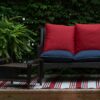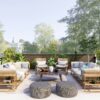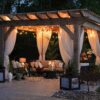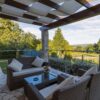In the age of open spaces and fluid living, the boundary between indoor and outdoor spaces is increasingly blurred. Homeowners are looking to create cohesive environments that offer the comforts of indoor living alongside the natural beauty of the outdoors. In this blog, we explore the art of blending indoor and outdoor living through carefully selected home and garden furniture.
The Vision of Integrated Living
Integrated living is more than a design trend—it’s a lifestyle that prioritizes flexibility, comfort, and a connection with nature. By extending your living space to include both indoor and outdoor areas, you create an environment that nurtures creativity, wellness, and social connections.
Breaking Down Barriers
Traditional home design often treats the indoors and outdoors as separate realms. Today, however, homeowners are seeking a seamless transition that allows for uninterrupted flow between spaces. Here’s how to begin:
Open Floor Plans: Embrace open floor plans that allow natural light and fresh air to flow throughout your home. Large glass doors and windows can serve as gateways between your indoor living area and your outdoor sanctuary.
Consistent Aesthetics: Use similar materials, color palettes, and design elements in both spaces to create a sense of continuity. For instance, wooden accents or neutral tones can unify disparate areas.
Multi-Functional Furniture: Invest in furniture that adapts to both indoor and outdoor use. Pieces that are designed for versatility enable you to shift the boundaries of your living space with ease.
Designing Your Indoor-Outdoor Haven
Creating a balanced indoor-outdoor space requires thoughtful planning and a deep understanding of your lifestyle. Let’s dive into some practical ideas for designing your integrated haven.
Indoor Living with a Touch of Nature
Bringing natural elements indoors can make your home feel more vibrant and connected to the outdoors. Consider these design strategies:
Biophilic Design: Incorporate elements of nature such as indoor plants, natural textures, and organic materials. This approach not only enhances aesthetics but also improves air quality and well-being.
Natural Light: Maximize the flow of natural light with large windows, skylights, and open layouts. The interplay of light and shadow can transform your space throughout the day.
Textural Harmony: Use fabrics and materials that echo nature. Linen, cotton, and wood accents can create a warm, inviting atmosphere that mirrors the outdoors.
Outdoor Furniture That Complements Indoor Design
Your garden or patio should feel like a natural extension of your home’s interior. Here are some ways to achieve this:
Coordinated Colors and Materials: Choose garden furniture that complements the colors and textures found in your indoor spaces. Neutral or earthy tones tend to work well in both settings.
Comfort and Durability: Outdoor pieces must be both stylish and resilient. Look for weather-resistant fabrics and materials that provide comfort without sacrificing design.
Flexible Configurations: Consider modular outdoor furniture that can be rearranged to suit different activities—whether it’s a casual brunch or an evening cocktail party.
Practical Tips for a Seamless Transition
Creating harmony between your indoor and outdoor spaces is an art that involves both design and functionality. Here are some practical tips:
Unified Flooring: Extend your flooring material from the interior to the exterior. Porcelain tiles, natural stone, or even polished concrete can provide a cohesive look.
Outdoor Rugs and Accents: Use outdoor rugs to define seating areas and tie in the color schemes from your indoor decor.
Integrated Lighting: Lighting is crucial for setting the mood. Use a mix of ambient and task lighting to create a smooth transition from the day’s brightness to the evening’s intimacy.
Seamless Entryways: Design entryways that invite you to step out into your garden. Sliding glass doors or wide French doors can be both practical and visually appealing.
Benefits of an Integrated Indoor-Outdoor Lifestyle
The advantages of merging indoor and outdoor spaces go beyond aesthetics. This lifestyle offers numerous benefits:
Enhanced Well-Being
Natural light, fresh air, and greenery have been proven to reduce stress and boost mood. An integrated living space allows you to enjoy these benefits every day.
Stress Reduction: The presence of natural elements can help lower stress levels, leading to a more relaxed, balanced lifestyle.
Improved Air Quality: Increased ventilation and access to fresh air contribute to better indoor air quality, which is essential for overall health.
Connection with Nature: A seamless indoor-outdoor flow fosters a deeper connection with nature, which can enhance creativity and mental clarity.
Flexibility and Adaptability
A home that fluidly transitions between indoor and outdoor spaces offers incredible flexibility:
Multi-Use Spaces: Adapt your living areas to suit your needs. A sunlit patio can double as a workspace or a play area for children.
Entertaining Made Easy: Host gatherings in a space that offers the comforts of home alongside the freedom of outdoor living.
Year-Round Enjoyment: With appropriate weatherproofing and design, you can enjoy your integrated space in every season.
Case Studies and Inspiration
Numerous homeowners have successfully integrated indoor and outdoor living with stunning results. Let’s look at a few case studies for inspiration:
Urban Oasis
In a bustling city apartment, large sliding glass doors open onto a small, beautifully landscaped terrace. The interior features light, airy colors and natural wood accents that echo the greenery outside. The result is an urban oasis where residents can escape the city’s hustle and reconnect with nature without leaving their home.
Suburban Sanctuary
A suburban home boasts a spacious patio furnished with weather-resistant yet elegant outdoor furniture. The design features a consistent color scheme and design motifs that mirror the indoor decor, creating a seamless flow from the living room to the garden. This approach not only maximizes space but also creates a unified look that enhances the overall appeal of the property.
Rustic Retreat
A countryside home embraces a rustic aesthetic by using reclaimed wood and vintage-inspired pieces both indoors and outdoors. The integration of natural materials and earthy tones creates a warm, inviting atmosphere that blurs the line between indoor comfort and outdoor adventure.







